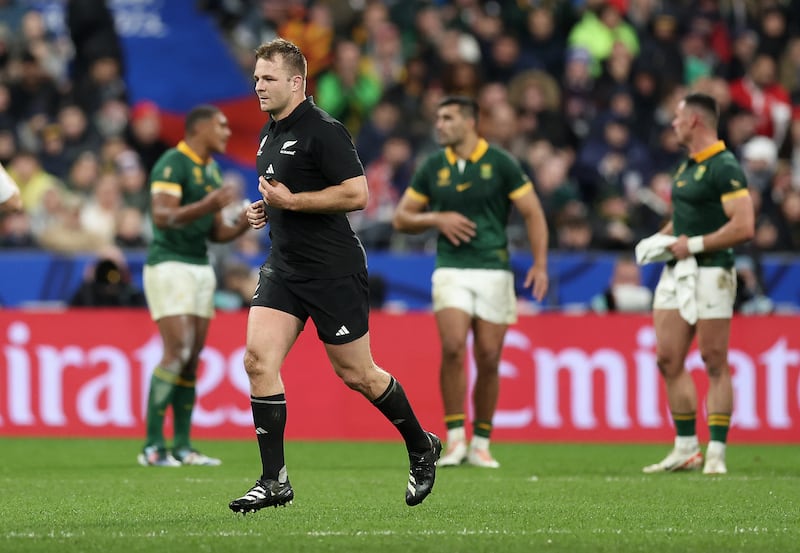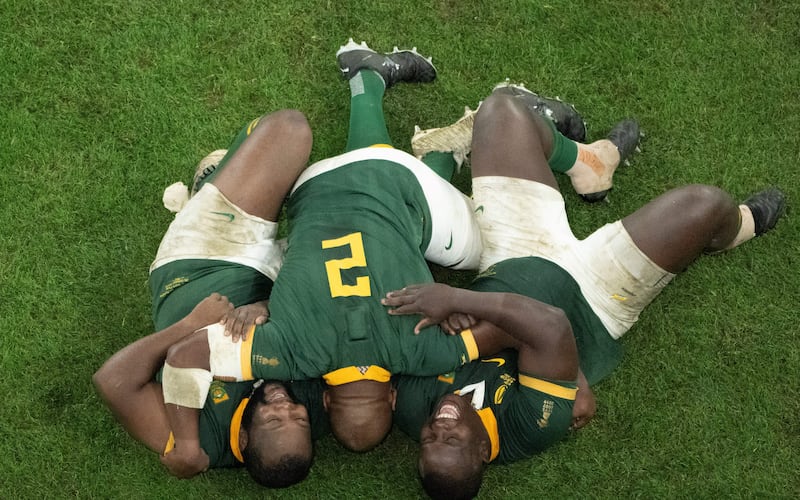The Rainbow Nation lustily celebrated the retention of their title as world champions as South Africa lifted the Webb Ellis trophy, the fourth time in their history and for the second occasion accomplishing that landmark in Paris.
Springbok supporters bring a vibrant colour to match their love of the sport, whether manifested in some of their supporters singing and dancing beneath the Eiffel Tower or those lucky enough to get a first-hand view in the Stade de France. Few players managed to get their hands on the trophy quicker than South African president Cyril Ramaphosa, captain Siya Kolisi just about getting there first.
Kolisi is a wonderful advocate for South African rugby as a person and a player, a man for others in the truest sense, as he demonstrated in support of Manie Libbok and in sprinting to the touchline to envelop Cheslin Kolbe at the final whistle as the wing’s sinbin purgatory came to an end; Kolbe had spent much of the 10-minute sabbatical, tortoise-like with his head hidden beneath the neckline of his jersey.
South Africa’s unbreakable mental strength was a decisive factor through the knockout stages of the World Cup, but it would be remiss not to mention that Lady Luck bestowed her favours on the Springboks. That doesn’t in any way diminish their triumph. Most teams need help here and there to win trophies.
READ MORE
After they squeezed through against France in a quarter-final, the coaching team’s in-play decisions helped them past England in the semi-final and then having opted for a 7-1 split on the bench, they managed to avoid injury to an outside back. Kolisi’s yellow card could easily have been red on another day.
New Zealand were drawn to try to match the Springboks physically and, in the testosterone-filled collisions All Blacks captain Sam Cane miscalculated in his tackle on Jesse Kriel and saw red. As the game unfolded, New Zealand’s natural attacking approach came to the fore, but it was always one player short in the wider channels to create the requisite breakthrough.

The World Cup was meant to be about attacking rugby, high ball-in-play time with lighting quick rucks for Antoine Dupont, Jamison Gibson-Park and Aaron Smith to dictate the tempo of high-octane matches. We got a taste of this on a few occasions, but for the most part the rugby side of this tournament peaked with the quarter-finals between the top four teams in the world.
There was plenty of tension and excitement to follow, England’s defiance almost earned a way past the eventual champions. This tournament, much like several others before, was about defence and set-piece dominance, and as we moved through the knockout stages it was South Africa who had the most impressive credentials under those parameters.
Pieter Steph du Toit led the tackle stats in the final with an eye-watering 28, dislodging the ball and possibly some fillings with the power of those hits. An obvious example was his beautifully-timed impact on Beauden Barrett just before halftime.
The set-piece, and in particular the scrum, has been the source of intense debate over the last few weeks. As the game has evolved in the professional era, South Africa have never deviated from their belief that a prop’s primary responsibility lies in the scrum.
South Africa sprang Ox Nche and Trevor Nyakane from the bench in the final. Scrummaging in South Africa starts at 10 years upwards with what seems little limitation or restrictions. It is an art form where they prize the big man almost as much if not more than the outside back.

The World Cup cycle offers a natural finishing point, and this latest edition is no different as the world of rugby waves goodbye to Johnny Sexton and some other outstanding players such as England’s Courtney Lawes, a host of All Blacks who will head for club rugby in Japan, and, if reports are true, Kolisi.
Inevitably the focus alights on the future as coaches look to the short, medium, and long-term evolution of style of play and the personnel who can implement the game plan. I have been that soldier, the past, present, and future at one stage or another in my career following World Cups.
I was one of the young players in 1999, tried to break that quarter-final glass ceiling in others, and finally, was put out to pasture in 2015. With the very real prospect of rugby fatigue setting in, I was more than content to keep an eye on rugby results this weekend rather than any compulsion to go to watch in any detail or go to a game.
Curiosity did get the better of me though. Leinster outhalf Ross Byrne will be eager to get back to playing rugby with the province given his limited game time in France, especially as there is a very interesting battle simmering between his young brother Harry and Sam Prendergast for the min jersey.

I like how Harry Byrne plays rugby, as did Andy Farrell when he capped him in November 2021 but injuries have held him back at almost every turn. Prendergast applied very subtle pressure in Leinster’s weekend win over the Sharks at the RDS, with a composed cameo from the bench capped by a beautiful change of direction and cross field kick for Tommy O’Brien to claim a try.
I learned that six months can be life-changing in rugby back in 2004 in advance of the Six Nations. In the last two years the competition has heated up dramatically for the 10 jersey, albeit that no one was able to take it from Sexton.
Ross Byrne restored the Irish coaches’ faith in him to head to France, but it was Jack Crowley that returned from the World Cup in pole position to replace Sexton as Ireland’s first-choice outhalf. The same type of jostling will be happening in almost every position, with the selection criteria different from just a couple of months ago.
The next cycle has already begun and several rounds in the URC and four at the pool stages of the Champions Cup will set the tone in selection terms for the upcoming Six Nations. There will be a few new faces and a couple of familiar ones, with Joey Carbery and Jacob Stockdale reminding everyone they are still here. There is always a surprise or two, something to which to look forward over the next couple of months.
















